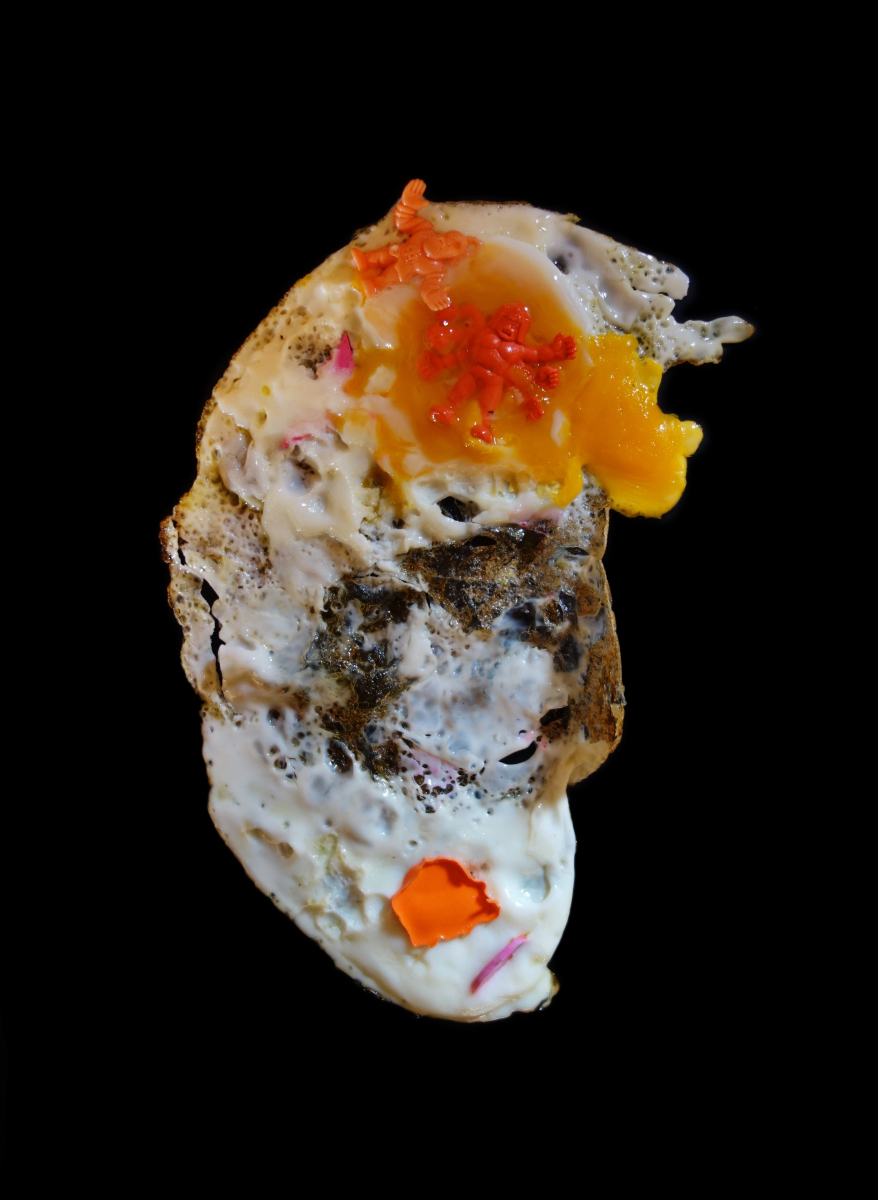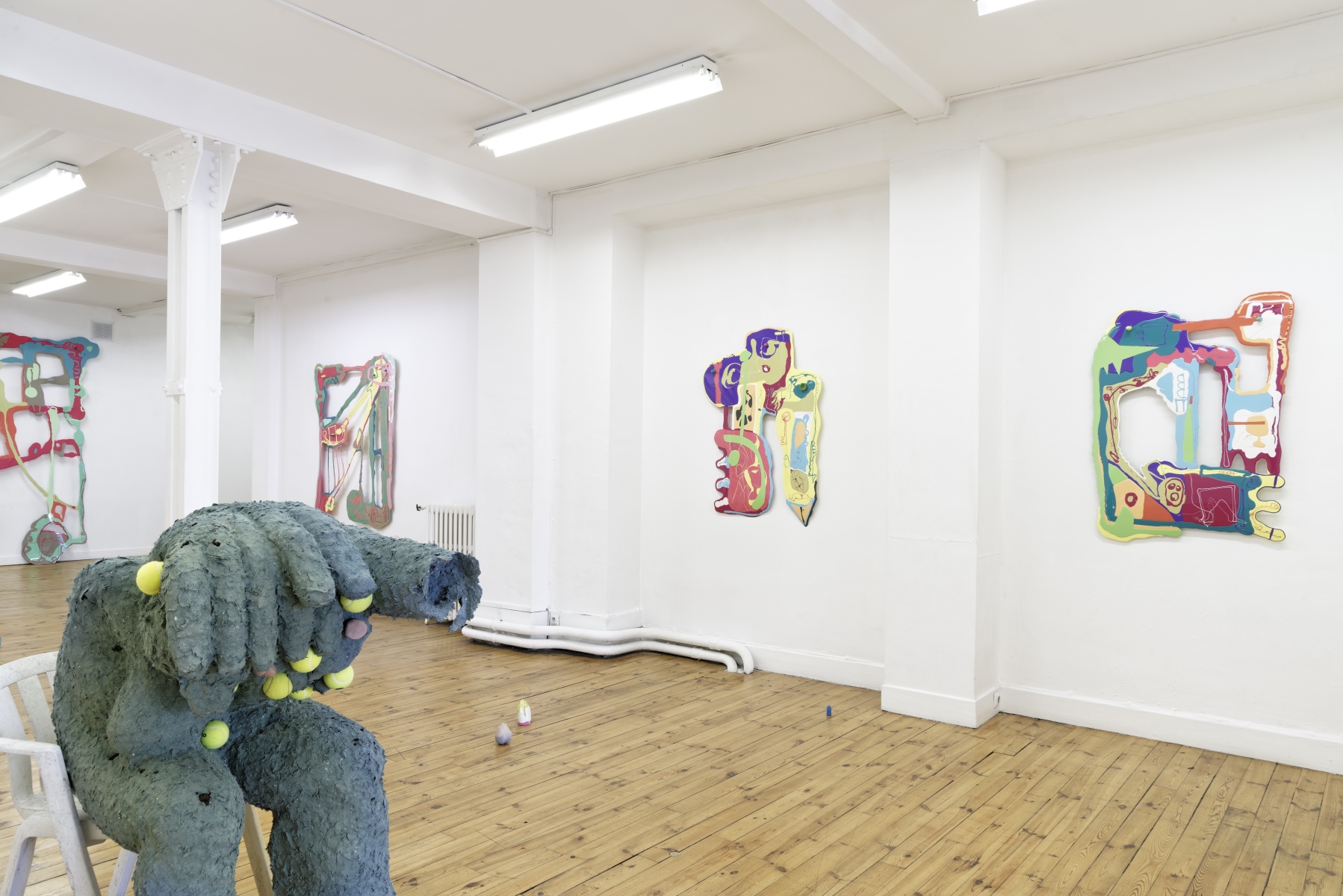Nicolas Momein
Finger trap, curated by Anne Favier
April 18 - June 01, 2019
Nicolas Momein
Finger trap, curated by Anne Favier
April 18 - June 01, 2019
She goes where she wants
“I forge the concept of floppiness”.
Jean-Baptiste Botul, La métaphysique du mou.
This exhibition in Saint-Etienne of recent works by Nicolas Momein is the first part of a double presentation that will be completed at the Ceysson & Bénétière gallery in Paris in September 2020.
The works displayed were conceived in the unusual space of a studio-dwelling, lasting the length of a residence. In these privileged conditions, the artist was able to coexist and interact with particular materials. As is often the case with Nicolas Momein, it is necessary for “it all to start from the material” and with its properties being worked for something else than the original purpose.
Amazed by the potential of unconventional materials (bulgomme, terry towel, rock wool, salt lick stone, soap, sedimented latex, wasabi paste...) diverted from their uses of which they still retain the memory, Nicolas Momein makes use of them as plastic materials that he shapes or submits to processes of transformation.
Today, he questions the astonishing plasticity and properties of industrial and composite technic al pastes: a kind of ultra-resistant rubbery resin and an air-hardening paste. One allows itself to be manipulated and kneaded with docility before crystallising ; the other must be poured before maintaining the form of its outpouring. The artist is particularly interested in the paradoxical density of these transiently supple and fluid materials, and the strangeness caused by the hardness of their softness. The resulting effects manifest the uncommon intermediate state constitutive of these mesomorphic substances. “Aujourd’hui, plus qu’à aucune autre époque, l’artiste a choisi de laisser à la matière sa propre réalité énergétique”(1).
Polyurethane rubber is generally used in industry for the manufacture of moulds. Here it is polychromic, tinted vividly in the mass, poured horizontally, without constraint, or else into provisional frames which circumscribe it and delimit the extent of the outpouring. While the material seems to go where it wants, emancipated from its original condition, it is nevertheless cleverly oriented by design of the artist who makes play with the tension between the indocility of the fluid resin and a striving for its domestication. The artist draws in the coloured material via an uninhibited pop palette, rejecting the conformity of elegance to tend towards an unseemly ‘baroqueism’. The contrasting flows are amalgamated, incorporated, aggregated, sutured, patched... What this action leads to is a free-flowing corporeality with graphic ‘street bubble’ aesthetics, echoing the pictorial creatures of Elyzabeth Murray or the volumes of Linda Benglis. Other pieces, semi-framed surfaces, also recall an ontological frame, but appear mostly as coloured sections, panels, moving paintings that could become curtains or floor mats, and suggest some improbable domestic uses. The ambiguity of this functional linkage is recurrent in Momein’s work.
Puddles of elastic resin can also be stretched vertically (exacerbating the perception of their density), supported by frail structures modelled in flesh-pink paste and augmented with linked grafts. These are thus freestanding sculptures, so many gangly figures recalling the hesitant figures of Philip Guston. Other volumes also echo the pictorial chimeras of the American painter. Covered with the flesh-pink skin resembling an unlikely epidermis, they are indeterminate biomorphic volumes that evade any taxonomy. Shapeless, they nevertheless present themselves as autonomous bodies driven by their own morphogenesis. “Le fragment du corps disparaît au profit d’un corps fragment bien plus inquiétant”(2).
These metonymic bodies also appear with the strange multicoloured Knots, cast in the elastomeric material that cannot be manipulated. They are casts filled with swollen, knotted, crowded, choked hands, together producing a language of puffy signs. These contorted fingers still give a clue of the hollowed out body.
The confusing sensuality of the pieces in this exhibition makes them “prières de toucher (3)” items; and the haptic dimension – “the possibility in the object of perceiving aspects that awaken the memory of the experience of touching” – according to Alois Riegl, is indeed an unchanging aspect of the work of Nicolas Momein.
(1) “Today, more than at any other time, the artist has chosen to leave matter its own energy-filled reality” [our translation], Maurice Fréchuret, Le mou et ses formes. Essai sur quelques catégories de la sculpture au XX° siècle, Nîmes, Ed Jacqueline Chambon, 2004, p. 19.
(2)“The fragment of the body disappears in favour of a far more disturbing fragmentary body” [our translation], Georges Didi-Huberman, in L’empreinte, Paris, Ed. Du Centre Georges Pompidou, 1997, p. 98.
(3) With reference to Marcel Duchamp’s work: Prière de toucher, 1947.
“I forge the concept of floppiness”.
Jean-Baptiste Botul, La métaphysique du mou.
This exhibition in Saint-Etienne of recent works by Nicolas Momein is the first part of a double presentation that will be completed at the Ceysson & Bénétière gallery in Paris in September 2020.
The works displayed were conceived in the unusual space of a studio-dwelling, lasting the length of a residence. In these privileged conditions, the artist was able to coexist and interact with particular materials. As is often the case with Nicolas Momein, it is necessary for “it all to start from the material” and with its properties being worked for something else than the original purpose.
Amazed by the potential of unconventional materials (bulgomme, terry towel, rock wool, salt lick stone, soap, sedimented latex, wasabi paste...) diverted from their uses of which they still retain the memory, Nicolas Momein makes use of them as plastic materials that he shapes or submits to processes of transformation.
Today, he questions the astonishing plasticity and properties of industrial and composite technic al pastes: a kind of ultra-resistant rubbery resin and an air-hardening paste. One allows itself to be manipulated and kneaded with docility before crystallising ; the other must be poured before maintaining the form of its outpouring. The artist is particularly interested in the paradoxical density of these transiently supple and fluid materials, and the strangeness caused by the hardness of their softness. The resulting effects manifest the uncommon intermediate state constitutive of these mesomorphic substances. “Aujourd’hui, plus qu’à aucune autre époque, l’artiste a choisi de laisser à la matière sa propre réalité énergétique”(1).
Polyurethane rubber is generally used in industry for the manufacture of moulds. Here it is polychromic, tinted vividly in the mass, poured horizontally, without constraint, or else into provisional frames which circumscribe it and delimit the extent of the outpouring. While the material seems to go where it wants, emancipated from its original condition, it is nevertheless cleverly oriented by design of the artist who makes play with the tension between the indocility of the fluid resin and a striving for its domestication. The artist draws in the coloured material via an uninhibited pop palette, rejecting the conformity of elegance to tend towards an unseemly ‘baroqueism’. The contrasting flows are amalgamated, incorporated, aggregated, sutured, patched... What this action leads to is a free-flowing corporeality with graphic ‘street bubble’ aesthetics, echoing the pictorial creatures of Elyzabeth Murray or the volumes of Linda Benglis. Other pieces, semi-framed surfaces, also recall an ontological frame, but appear mostly as coloured sections, panels, moving paintings that could become curtains or floor mats, and suggest some improbable domestic uses. The ambiguity of this functional linkage is recurrent in Momein’s work.
Puddles of elastic resin can also be stretched vertically (exacerbating the perception of their density), supported by frail structures modelled in flesh-pink paste and augmented with linked grafts. These are thus freestanding sculptures, so many gangly figures recalling the hesitant figures of Philip Guston. Other volumes also echo the pictorial chimeras of the American painter. Covered with the flesh-pink skin resembling an unlikely epidermis, they are indeterminate biomorphic volumes that evade any taxonomy. Shapeless, they nevertheless present themselves as autonomous bodies driven by their own morphogenesis. “Le fragment du corps disparaît au profit d’un corps fragment bien plus inquiétant”(2).
These metonymic bodies also appear with the strange multicoloured Knots, cast in the elastomeric material that cannot be manipulated. They are casts filled with swollen, knotted, crowded, choked hands, together producing a language of puffy signs. These contorted fingers still give a clue of the hollowed out body.
The confusing sensuality of the pieces in this exhibition makes them “prières de toucher (3)” items; and the haptic dimension – “the possibility in the object of perceiving aspects that awaken the memory of the experience of touching” – according to Alois Riegl, is indeed an unchanging aspect of the work of Nicolas Momein.
(1) “Today, more than at any other time, the artist has chosen to leave matter its own energy-filled reality” [our translation], Maurice Fréchuret, Le mou et ses formes. Essai sur quelques catégories de la sculpture au XX° siècle, Nîmes, Ed Jacqueline Chambon, 2004, p. 19.
(2)“The fragment of the body disappears in favour of a far more disturbing fragmentary body” [our translation], Georges Didi-Huberman, in L’empreinte, Paris, Ed. Du Centre Georges Pompidou, 1997, p. 98.
(3) With reference to Marcel Duchamp’s work: Prière de toucher, 1947.
Text by Anne Favier
Exhibition with the support of the Saint Ange Residency, Seyssins.
Exhibition with the support of the Saint Ange Residency, Seyssins.
Artist : Nicolas Momein
Visitor Information
Ceysson & Bénétière
8 rue des Creuses
42000 Saint-Étienne
Wednesday - Saturday
2pm - 6pm
T: + 33 4 77 33 28 93








